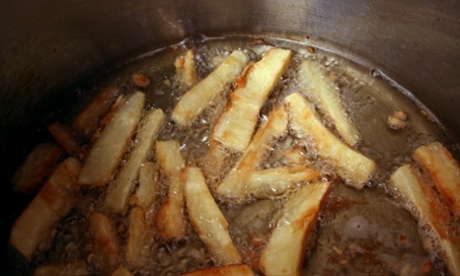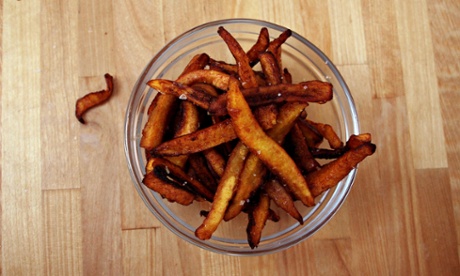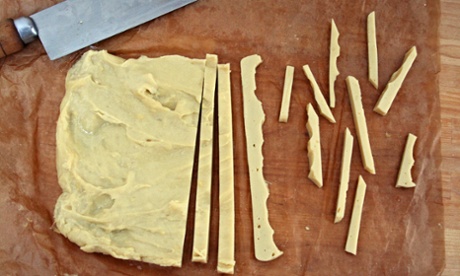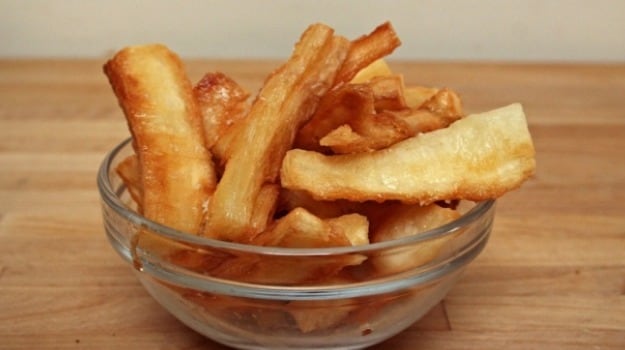The chip is such a success story of the modern world that attempts to reinvent it are constant. But can cassava, plantain or chickpeas really replace the mighty spud?
It's official: French fries, McDonald's golden sticks of deliciousness, are made from potatoes. It says a lot that this fact wasn't immediately obvious to a public still scarred by memories of the "pink slurry" burger, but in its latest marketing exercise - "Our food, your questions" - the chain invited "MythBuster" Grant Imahara behind the counter to trace the fries back to their roots. He found a mighty 19 ingredients in the chips - dextrose, "natural beef flavour", dimethylpolysiloxane (mmmm) - and, ta-daaa, potatoes - mostly russets, apparently.
Not that a chip needs to come from a potato to be called such these days. The chip has been such a global success story that attempts to reinvent it are constant. Things that have been given the chip mantle include - but are by no means limited to - parsnips, sweet potatoes, kale and courgette (although I think that the latter might fall into the tempura category).
It doesn't always work. I once had the traumatic experience of sampling an avocado chip, which involved a collapsed sort of gluey batter covering a lukewarm blob of green slurry. It wasn't nice, and it wasn't a chip. We need more rules regarding the usage of the word chip: if a foodstuff can be cut into a baton and retain said shape after a dip in hot oil without the help of a batter, it's a chip. Otherwise, it's not.
But can anything really beat the mighty potato? And more specifically, should you go to the trouble of walking past the potato aisle in search of more exotic ingredients if you're looking to satiate a chip craving at home?
For the purposes of this test, we're testing chips as a side dish (goodbye kale and courgette) to a burger. There are three chip alternatives: cassava, plantain and chickpea. In the interests of fairness, I've subjected them all to the same treatment: a shallow fry in sunflower oil, a scattering of sea salt, and ketchup and mayo to taste.
Cassava

Shopping: I've picked my vegetable vendor well. He takes each waxy length of cassava and chops both ends off to make sure the flesh inside is bright white, weighs what's left and tots up the total. Apparently, cassava doesn't travel well at this time of year and it's impossible to tell if it has turned black inside without slicing it open.
Method: This is my only alternative that is still a tuber, and as such the chip-making process is - in theory - similar to that of a potato chip. It must be peeled and cut into roast potato-sized rounds. Beware, coaxing the bark-like exterior off these vegetables is not as easy as Nando Cuca makes it look here. If you were making cassava chips for a crowd, you'd need wrist supports. Next, it needs to be simmered until tender (this can take as long as 30 minutes). When your drained cassava are cooled and dry, you slice each round in half and remove the stem before breaking the fibrous flesh into chips. The resultant chips are chunky - any attempt to make thin fries ends in mush.
Verdict: They cook beautifully, the fibrous surface turning golden immediately. The cassava doesn't even have to try; it achieves the sort of crispiness that a standard chip triple-fried in duck fat can only dream of. But I made enough cassava to feed four and I felt it in my wrist the following morning - enough of a reason to knock a point off. They were delicious, crispy beasts, with moreish, slightly sweet centres, but the process is laborious. Order them when you're out, I say. Or make them in, but ensure there are only two of you and you've got some mayo (mixed with a good squeeze of lime) for lubrication - they're a touch on the stodgy side.
4/5
Plantain

Shopping:I'm advised to opt for green plantain for a crispier chip, but when I tell the stallholder what I'm buying them for, he isn't convinced. He gets a second opinion from his wife and she nods towards the lesser bruised of the yellow. I buy both.
Method: As I unpeel them, the green plantain feels like it makes more sense as chip material. It lacks the banana sliminess of the yellow and feels appropriately starchy. I move on to peeling and chopping. There's not much to making a plantain chip. The sugar content in the yellow plantain means that they immediately blacken around the edges upon cooking and refuse to crisp up - they're tasty, but soggy. The green ones turn golden, like good chips. Their extreme starchiness makes for some commendable crispiness, but it's also responsible for a rather bland and arid chip.
Verdict: I suspect that using your plantain at precisely the right stage of its ripeness is important here. Perhaps mine were a touch too green. They certainly tasted green. The yellow ones were sweet, dense and soft. However, the word "fries" didn't fit, and there's enough sweetness going on in burgers these days without the chip joining in.
3/5
Chickpea

Shopping: Chickpea flour is more commonly called gram flour or besan, and is widely available in supermarkets, although it tends to come in huge sacks and be stacked in odd places - the sort of treatment that all ingredients must endure until they've gained popularity. (With the likes of food writer Gizzi Erskine and chef Yotam Ottolenghi using it liberally in recipes, this is only a matter of time.)
Method: This is the only chip that doesn't start with peeling. A chickpea chip is something that comes about by heating a mixture of chickpea flour and water until it thickens into a custard. This is then poured into a tray and flattened before it rapidly hardens, and the block is chopped into chips. I search online for guidance on flour-to-water ratios, and all seem to agree that two parts water to one part flour is standard. There are a few other ideas floating around, like adding a dusting of flour or leaving overnight, but I'm looking for a new chip that shares the simplicity of an old chip, so I ignore them. After my mix has cooled into a rubbery slab (at room temperature), I slice it up into fries. It's easy to be quite precise, so I end up with slimline batons to be proud of.

Verdict: The resultant chips evenly turn a light golden colour in the oil. They look like they could have been purchased from the golden arches themselves. It's uncanny. Dare I say it: this is better than a chip. And I didn't have to peel a thing. It has an even, crispy shell that gives way to a creamy, soft centre. Much like its potato brother, the chickpea chip plays a great supporting role. It's the sort of chip that could stand alone, but it still lets the burger be the main event. If you're not already in possession of a sack of gram flour, I say go forth and purchase one.
5/5
Picture Courtesy: Hen Clancey. Fry a little tenderness ... cassava chips.











